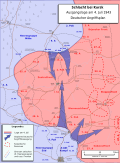Salients, re-entrants and pockets
A salient is a battlefield feature that projects into enemy territory.[1] The attacking troops creating the salient are vulnerable to attack from the front and flanks of the salient. The enemy's line facing a salient is referred to as a re-entrant (an angle pointing inwards). A deep salient is vulnerable to being "pinched out" across the base. If that happens the attackers are then surrounded.* This is what happened at the Battle of the Bulge in World War II.[2]
In fortifications, a salient is a part of the defense structure that sticks outward.[1] * note." Surrounded" means the enemy faces you on a 360 degree front .If the "encirclement" is not a complete 360 degrees, you are niether "surrounded", nor "encircled"
Examples
- At the Battle of Gettysburg, during the American Civil War, Union General Daniel Sickles moved his III Corps ahead of the main line of the Union army without orders. This caused him to be nearly cut off from the main army when the Confederates attacked. Sickles had held a similar position at Catherine's Furnace in the Battle of Chancellorsville two months earlier. In both cases his corps was badly mauled and had to be rescued by other units.
- At the Battle of Spotsylvania during the American Civil War, Confederate forces constructed a timber-reinforced line of trenches. The trench line bulged forward to protect a piece of high ground. This curve became known as the Mule Shoe Salient. Union troops concentrated their attack on this point. After 22 hours of hand-to-hand fighting they broke through. The Confederates pulled back to a new position.
- In World War I, the British occupied a large salient at Ypres for most of the war. Formed as a result of the First Battle of Ypres, it became one of the most bloody sectors of the Western Front. When anyone in the British infantry spoke of "The Salient", it was understood that they were referring to Ypres.[3]
- A similar salient existed around the French city of Verdun. The Battle of Verdun around it cost both sides heavy casualties.
- Also in World War I, the Germans occupied a small salient in front of Fromelles. It was called the Sugarloaf due to its distinctive shape.
- In World War II, the Soviet Union occupied a massive 150 kilometres (93 mi) deep salient at Kursk. It became the site of the largest tank battle in history and a decisive battle on the Eastern Front.
- In World War II, the German Army launched a surprise attack against advancing Allied forces in the Ardennes. It became commonly known as the Battle of the Bulge (also known as the Ardennes Offensive and the Von Rundstedt Offensive).
Salients, Re-entrants And Pockets Media
German attack plan (blue arrows) to pinch out Red Army-controlled Kursk salient, which resulted in the Battle of Kursk
German-occupied salient in the Ardennes on the eve of the Battle of the Bulge on December 15, 1944
- Map showing German forces pushing out through the tip of the salient in an attempt to penetrate into the rear of the Allied forces during the Battle of the Bulge, December 16–25, 1944.*Front line, 16 December*Front line, 20 December*Front line, 25 December
References
- ↑ 1.0 1.1 Edward Samuel Farrow, A Dictionary of Military Terms (New York: Thomas Y. Crowell Co., 1918), p. 531
- ↑ Robert E Merriam, Battle of the Bulge (Bennington, VT: Merriam Press, 2007), p. 43
- ↑ C. A. Rose, Three Years in France with the Guns: Being Episodes in the Life of a Field Battery (Luton, Bedfordshire: Andrews UK Limited, 2012), p. 21


